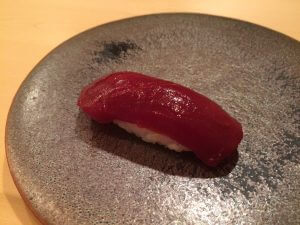 Zuke is one of the traditional Edo-style sushi methods. It is said that it was started in the Edo period to stop tuna from rotting when there were large amounts of the fish in the market. Now that there has been advances in refrigeration technology, it’s no longer necessary, but maturing the fish gives it a completely different taste and brings out its umami. Zuke is divided into two broad methods. Here we describe the characteristics of each.
Zuke is one of the traditional Edo-style sushi methods. It is said that it was started in the Edo period to stop tuna from rotting when there were large amounts of the fish in the market. Now that there has been advances in refrigeration technology, it’s no longer necessary, but maturing the fish gives it a completely different taste and brings out its umami. Zuke is divided into two broad methods. Here we describe the characteristics of each.
Recently, most sushi restaurants incorporate the “Single Zuke”.
Each slice of tuna is soaked separately, so it can mature quickly. The immersion time is only a few minutes. The idea is to marinate just enough so that the tuna’s aroma remains and the soy sauce doesn’t overtake it.
On the other hand, the old Edo-style method is to perform Zuke after parboiling.
Parboiling means to wrap the fish in a wet cloth, and poor boiling water on the wrapping until the color of the tuna changes color, then turn the fish over and repeat the process. The fish is then put in ice water so the heat doesn’t go too deep in the meat. It is immediately removed once it cools so that it doesn’t get too watery. The tuna is then put in Zuke soy sauce and left to marinate for about half a day. In this method, the soy sauce only soaks into the surface part where the color changed from the parboiling, so the flavor of the tuna remains.
Both methods keep the maximum tuna flavor possible. Tuna is an essential part of Edo-style sushi. There is great diversity between sushi restaurants in the parts, marinating time and flavor of Zuke, which creates a new, original flavor when the lean meat of the tuna soaks up the soy sauce. The fattiest cuts of tuna are most popular. The lean meat has only become more popular due to a rekindled interest in zuke, but in fact during the peak of the bubble economy, there was a time when high-end restaurants in Ginza didn’t know what to do with all their leftover lean tuna meat. It’s almost unbelievable to think of it now.
[sc_apply url=”https://sushiuniversity.jp/apply/”]
We hope this information will be helpful.

Revision date: August 1, 2017
Share this article
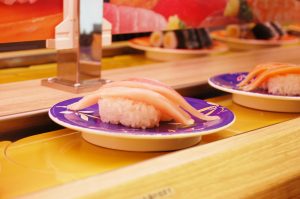 In some cases a two-piece sushi dish you can get for JPY 100 at Kaiten-zushi (Conver belt sushi) can cost up to 2,000 for half the volume at a fancy restaurant. Many Kaiten-zushi establishments are part of large chains so costs are kept low by buying in bulk.
In some cases a two-piece sushi dish you can get for JPY 100 at Kaiten-zushi (Conver belt sushi) can cost up to 2,000 for half the volume at a fancy restaurant. Many Kaiten-zushi establishments are part of large chains so costs are kept low by buying in bulk. While different from fancy sushi restaurants that serve various seasonal fish and edomaeshigoto, Kaiten-zushi has its own merits and offers sushi at a much lower price. It’s really up to the customer what they hope to get from their sushi experience.
While different from fancy sushi restaurants that serve various seasonal fish and edomaeshigoto, Kaiten-zushi has its own merits and offers sushi at a much lower price. It’s really up to the customer what they hope to get from their sushi experience.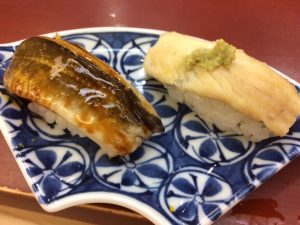 Sushi restaurants that advertise “Edo style” on the sign somewhat fear customers who order Anago (conger eel) right off the bat. If the customer then eats as if they are really taking the time to taste the sushi, then any chef not fully confident in their skills will want to hide under the sushi counter.
Sushi restaurants that advertise “Edo style” on the sign somewhat fear customers who order Anago (conger eel) right off the bat. If the customer then eats as if they are really taking the time to taste the sushi, then any chef not fully confident in their skills will want to hide under the sushi counter.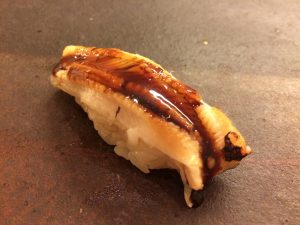
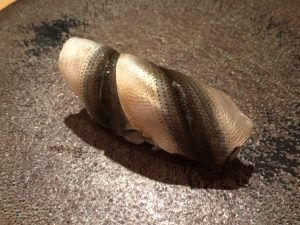 According to most sushi masters, salt is the defining factor in the taste of
According to most sushi masters, salt is the defining factor in the taste of 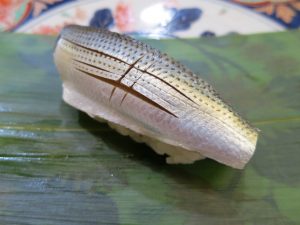 For example, a more slender fish in the middle of summer may be salted for 30 minutes, but a fatty fish in the winter needs to be salted for four hours. Just a few minutes longer or shorter than the perfect salting time completely changes the taste of the final dish.
For example, a more slender fish in the middle of summer may be salted for 30 minutes, but a fatty fish in the winter needs to be salted for four hours. Just a few minutes longer or shorter than the perfect salting time completely changes the taste of the final dish.